I have created an app that has a navigation drawer, it works fine, but the only problem is that I see two toolbars. One in which there is Actionbartoggle button and other which is default. Now the tutorial I have seen has used a toolbar in the main content of drawer layout and obviously navigation contents are coming from menu. Now the problem is I think we have to pass a toolbar reference in the constructor of Actionbardrawertoggle, and after I passed it properly it works fine, but I see two toolbars/actionbars. Basically my question is how do I get the toggle button on the main action bar and not get second tool bar created? I have tried using
<style name="MyTheme" parent="android:Theme.Material.Light.NoActionBar">
It helps me to hide the upper actionbar but I don't think it's the good way to do it. I am uploading my screenshot of output and code:
<android.support.v4.widget.DrawerLayout
xmlns:android="http://schemas.android.com/apk/res/android"
xmlns:app="http://schemas.android.com/apk/res-auto"
android:id="@+id/drawerLayout"
android:layout_width="match_parent"
android:layout_height="match_parent"
android:fitsSystemWindows="true">
<!-- Page Content -->
<LinearLayout
android:layout_width="match_parent"
android:layout_height="match_parent">
<android.support.v7.widget.Toolbar
android:id="@+id/toolbar"
android:layout_width="match_parent"
android:layout_height="wrap_content"
android:layout_alignParentTop="true"
android:background="@color/colorPrimary"
android:minHeight="?attr/actionBarSize"
app:theme="@style/ThemeOverlay.AppCompat.Dark.ActionBar"/>
</LinearLayout>
<!-- Navigation View -->
<android.support.design.widget.NavigationView
android:id="@+id/navigationView"
android:layout_width="match_parent"
android:layout_height="match_parent"
android:layout_gravity="start"
app:itemTextColor="#5DADE2"
app:menu="@menu/drawer_items"/>
</android.support.v4.widget.DrawerLayout>
Mainactivity:
import android.content.DialogInterface;
import android.content.Intent;
import android.os.Bundle;
import android.support.v7.app.AlertDialog;
import android.support.v7.app.AppCompatActivity;
import android.view.Menu;
import android.view.MenuInflater;
import android.view.MenuItem;
import android.view.View;
import android.widget.Button;
import android.support.annotation.NonNull;
import android.support.design.widget.NavigationView;
import android.support.v4.view.GravityCompat;
import android.support.v4.widget.DrawerLayout;
import android.support.v7.app.ActionBarDrawerToggle;
import android.support.v7.app.AppCompatActivity;
import android.os.Bundle;
import android.support.v7.widget.Toolbar;
import android.view.MenuItem;
import android.view.View;
import android.view.Window;
import android.widget.Toast;
import java.util.HashMap;
import android.content.DialogInterface;
import android.content.Intent;
import android.support.v7.app.AlertDialog;
import android.support.v7.app.AppCompatActivity;
import android.os.Bundle;
import android.view.View;
import android.widget.Button;
import java.util.HashMap;
public class MainActivity extends AppCompatActivity implements NavigationView.OnNavigationItemSelectedListener{
SessionManager session;
private Toolbar mToolbar;
private DrawerLayout mDrawerLayout;
ActionBarDrawerToggle drawerToggle;
@Override
protected void onCreate(Bundle savedInstanceState) {
super.onCreate(savedInstanceState);
setContentView(R.layout.activity_user_area);
setupToolbarMenu();
setupNavigationDrawerMenu();
}
@Override
public boolean onOptionsItemSelected(MenuItem item) {
// Handle item selection
switch (item.getItemId()) {
case R.id.lg:
session.logoutUser();
return true;
default:
return super.onOptionsItemSelected(item);
}
} private void setupToolbarMenu() {
mToolbar = (Toolbar) findViewById(R.id.toolbar);
mToolbar.setTitle("Home Page");
}
private void setupNavigationDrawerMenu() {
NavigationView navigationView = (NavigationView) findViewById(R.id.navigationView);
mDrawerLayout = (DrawerLayout) findViewById(R.id.drawerLayout);
navigationView.setNavigationItemSelectedListener(this);
navigationView.setItemIconTintList(null);
drawerToggle = new ActionBarDrawerToggle(this,
mDrawerLayout,mToolbar,
R.string.drawer_open,
R.string.drawer_close);
mDrawerLayout.addDrawerListener(drawerToggle);
drawerToggle.syncState();
} @Override // Called when Any Navigation Item is Clicked
public boolean onNavigationItemSelected(@NonNull MenuItem menuItem) {
closeDrawer();
switch (menuItem.getItemId()) {
case R.id.home:
// Put your Item specific Code here
break;
case R.id.invoice:
Intent intent = new Intent(this,details.class);
startActivity(intent);
// Put your item specific Code here
break;
}
return true;
}
// Close the Drawer
private void closeDrawer() {
mDrawerLayout.closeDrawer(GravityCompat.START);
}
// Open the Drawer
private void showDrawer() {
mDrawerLayout.openDrawer(GravityCompat.START);
}
@Override
public void onBackPressed() {
if (mDrawerLayout.isDrawerOpen(GravityCompat.START))
closeDrawer();
else{
new AlertDialog.Builder(this).setIcon(android.R.drawable.ic_dialog_alert).setTitle("Exit")
.setMessage("Are you sure?")
.setPositiveButton("yes", new DialogInterface.OnClickListener() {
@Override
public void onClick(DialogInterface dialog, int which) {
Intent intent = new Intent(Intent.ACTION_MAIN);
intent.addCategory(Intent.CATEGORY_HOME);
intent.setFlags(Intent.FLAG_ACTIVITY_NEW_TASK);
startActivity(intent);
finish();
}
}).setNegativeButton("no", null).show();}
}
}
my styles.xml file:
<resources>
<!-- Base application theme. -->
<style name="AppTheme" parent="Theme.AppCompat.Light.DarkActionBar">
<!-- Customize your theme here. -->
<item name="colorPrimary">@color/colorPrimary</item>
<item name="colorPrimaryDark">@color/colorPrimaryDark</item>
<item name="colorAccent">@color/colorAccent</item>
</style>
</resources>
I know this might not be of some use, but here's my manifest file too:
<?xml version="1.0" encoding="utf-8"?>
<manifest xmlns:android="http://schemas.android.com/apk/res/android">
<uses-permission android:name="android.permission.INTERNET"/>
<application
android:allowBackup="true"
android:icon="@mipmap/ic_launcher"
android:label="@string/app_name"
android:roundIcon="@mipmap/ic_launcher_round"
android:supportsRtl="true"
android:theme="@style/AppTheme">
<activity android:name=".details" />
<activity android:name=".Login"
android:label="Login"/>
<activity android:name=".MainActivity" />
<activity android:name=".recycler" />
<activity android:name=".RegisterActivity" />
<activity android:name=".SplashScreen">
<intent-filter>
<action android:name="android.intent.action.MAIN" />
<category android:name="android.intent.category.LAUNCHER" />
</intent-filter>
</activity>
</application>
</manifest>
